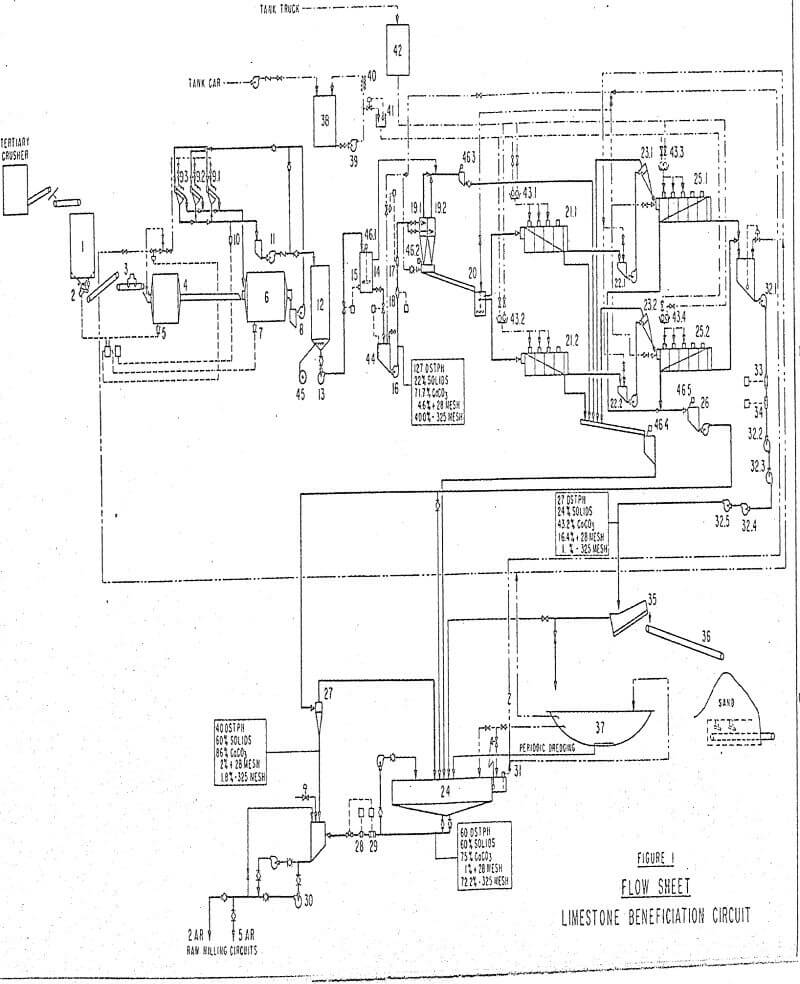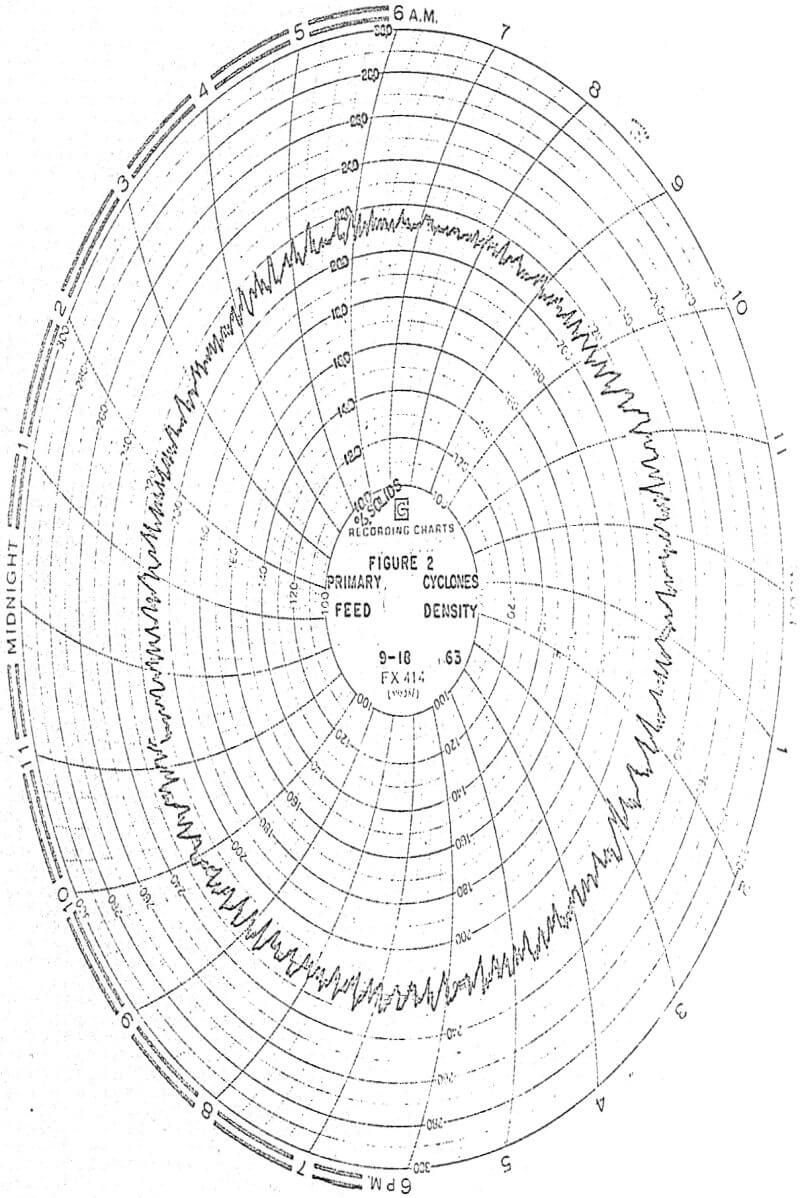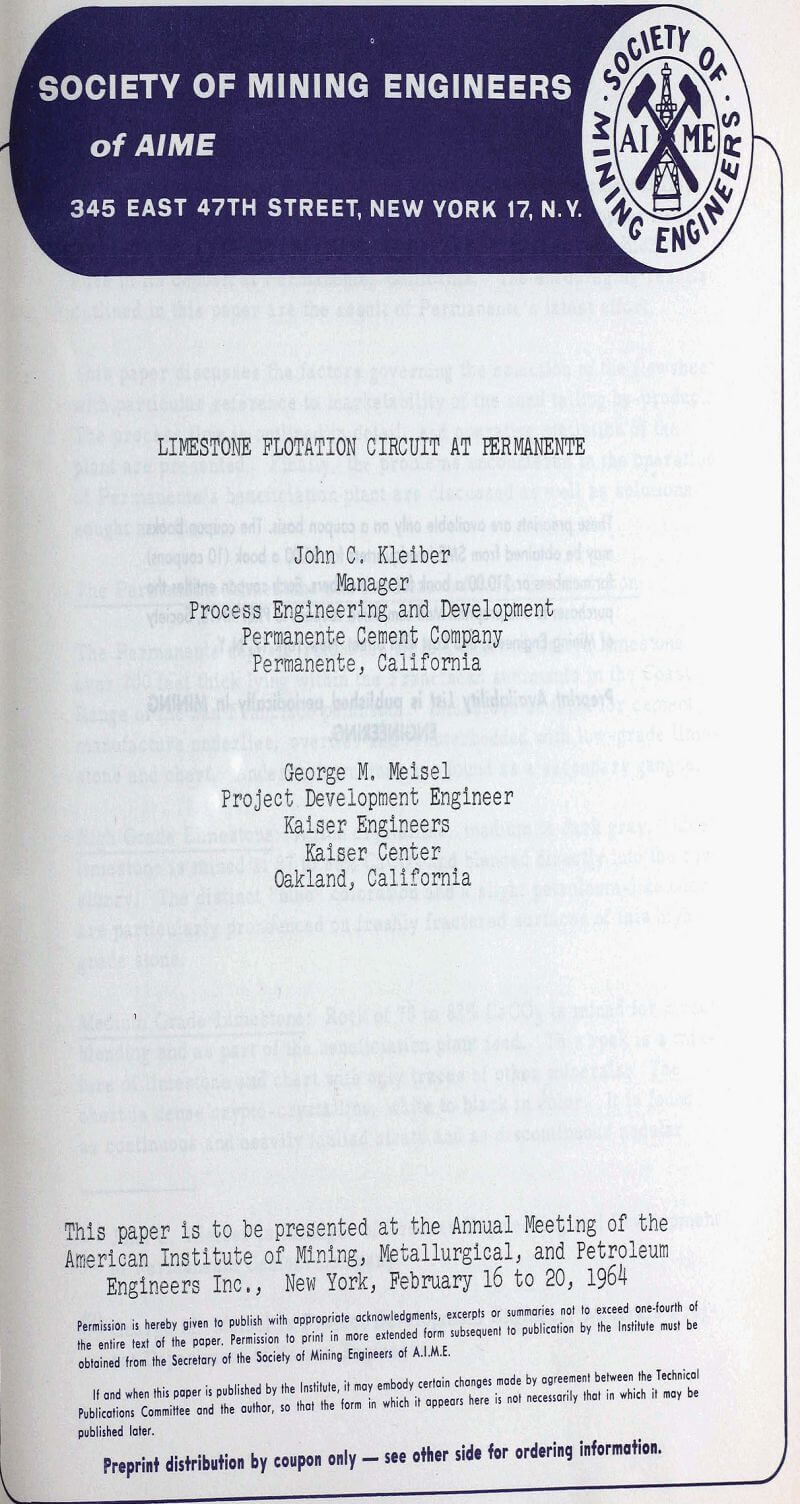Table of Contents
From time to time since the initial installation of an experimental flotation section in 1940, Permanente Cement Company has made efforts to beneficiate the low-grade limestone fraction which occurs in its deposit at Permanente, California.
Limestone and the Reason for Its Beneficiation
The Permanente deposit is a sheet of Calera limestone over 700 feet thick lying within the Franciscan sediments in the Coast Range of the San Francisco peninsula. Limestone suitable for cement manufacture underlies, overlies and is interbedded with low-grade limestone and chert. Andesite intrusions are found as a secondary gangue.
Mining Problems: Grade of limestone depends on the thickness and frequency of cherty strata, which differ widely in number and thickness in different sections of the Permanente deposit. While this facilitates selective mining, development of the quarry has progressed to the point where large quantities of low-grade cherty limestone are found over-lying and between the high-grade limestone strata. Thus, these low- grade limestones must be mined and either beneficiated or wasted to uncover and make available the high-grade rock required by the cement plant.
Hard green intrusive andesite cuts across the upper low-grade “light” limestone strata, and clay-like gangue is present along several thrust faults within the deposit. Mining in these areas must be carefully controlled so that only acceptable quantities of these materials are allowed to dilute the rock sent to beneficiation, or blended directly into the raw slurry. While the remainder must be wasted together with the limestone which it contaminates, some waste rock is sold as base, fill and aggregate stone.
Factors Governing Selection of Flowsheet
Selection of the flowsheet was governed by two factors established in the test work; differential grinding and utilization of tailing. As outlined before, differential grinding between the comparatively hard chert and the softer limestone resulted in upgrading of the CaCO3 content of the slimes. The tests indicated that a milling circuit approaching in the second stage semi-autogenous conditions with a charge of comparatively small 2-½ in. balls produced a slime concentrate of approximately 75% CaCO3.
Low-grade limestone, containing approximately 70% CaCO3, is crushed to approximately 6% plus ½ in. in two 5-½ ft Symons shorthead crushers with fine bowls, close circuited over 7/16 in. screens. The crushed material is conveyed to a 1, 200 ton cylindrical concrete storage bin (1), adjacent to No. 1 grinding circuit.
The mill is equipped with an electric sound control sensing device which serves to limit the feed; rate of the vibrating feeder only in case of overload conditions caused by coarse or hard feed. Four inch balls are used and 235 gallons per minute of dilution water are required for the average throughput of 127 tons per hour.
Addition of dilution water to the primary and secondary mills and the three vibrating screens also is controlled by the electric sound control sensing system, A diaphragm type differential pressure cell on a steady head leg of the screen undersize line monitors the. dilution of the product.
The slurry is drawn from the bottom of the agitator to a re pulping pump sump in which it is diluted to approximately 22% solids. A bubble tube type differential pressure control, regulates the rate of slurry flow from the agitator through a 3 in. diaphragm valve, thus maintaining a constant sump level.
The two banks of four cell primary flotation machines produce merely a slime froth concentrate. In this stage, 0.1 lb of fatty acid reagent per ton of feed is added to the first three cells of each bank. The slime froth concentrate contains approximately 72% CaCO3 and is laundered to the slime product thickener.The sand tailing of the primary slimes flotation circuit contains approximately 67% CaCO3 and is pumped to the secondary cyclones.
The rougher flotation concentrate, at approximately 35% solids, is pumped to the concentrate cyclone. The underflow from the concentrate cyclone aanalyzes approximately 86% CaCO3.
Operating Problems
Initial operation of the flotation circuit encountered the usual assortment of problems. Most have been solved; some remain to be solved. The principal problem areas will be discussed in the following paragraphs.
Grinding: In the course of operation, Permanente has varied the grind between 10 and 28 mesh.
Flotation Circuitry: With grinding parameters established by these considerations, it became necessary to restrict primary flotation to yielding of a secondary slime froth product. Thus, the bulk of the flotation concentrate is being produced in the subsequent rougher stage, which in spite of the nomenclature, scavenges the sand tails of the primary stage
Frothing: Deposition of calcium soaps tends to plug the concentrate line to the product cyclone, as well as the cyclone proper. This is reflected in an undesirable reduction in the solids content of the cyclone underflow.
Tailing Pumps: Serious difficulties were encountered with the tailing pumps originally installed. Neither closed nor open impeller types would stand up under the extremely abrasive service conditions, particularly in view of the high line velocity required to avoid settling out of the slime-free coarse sand tailings.



